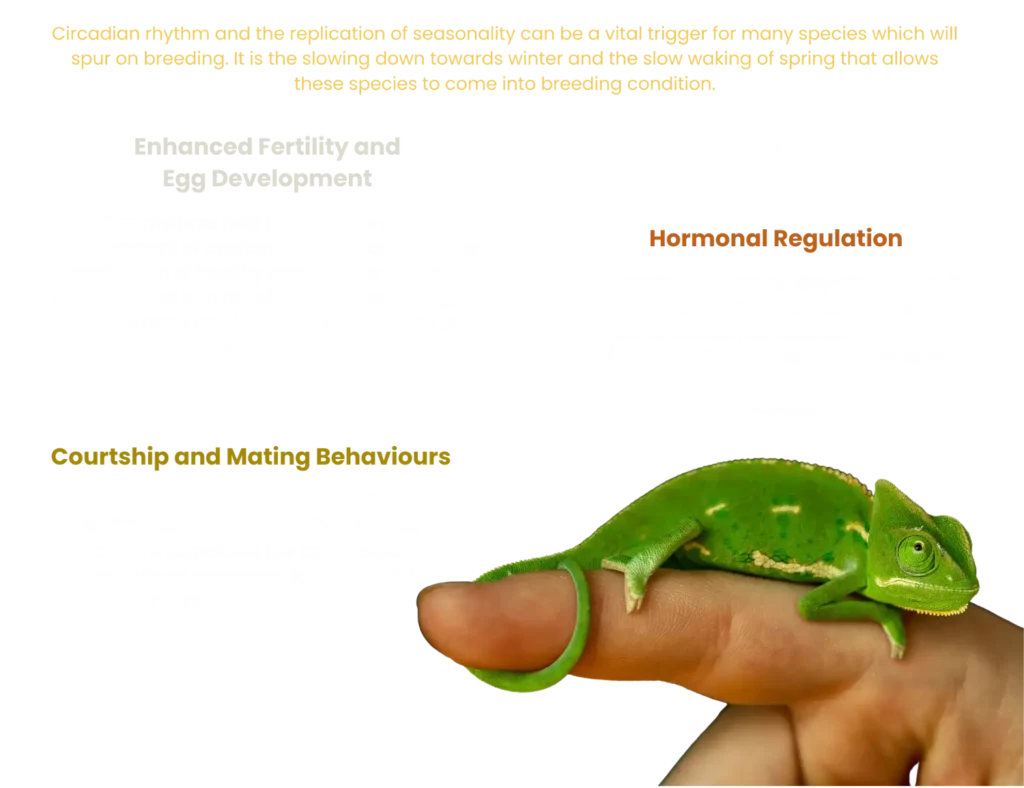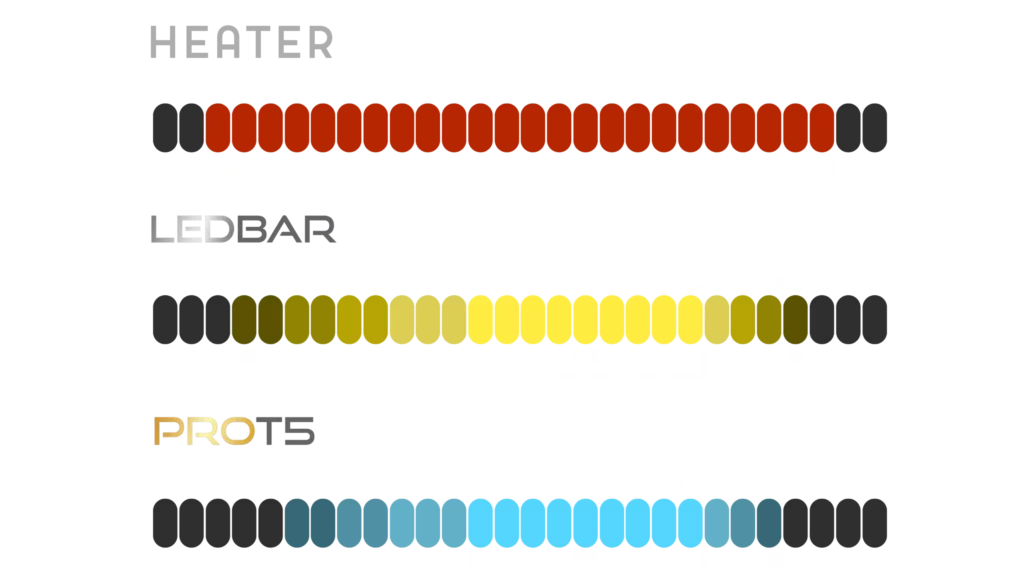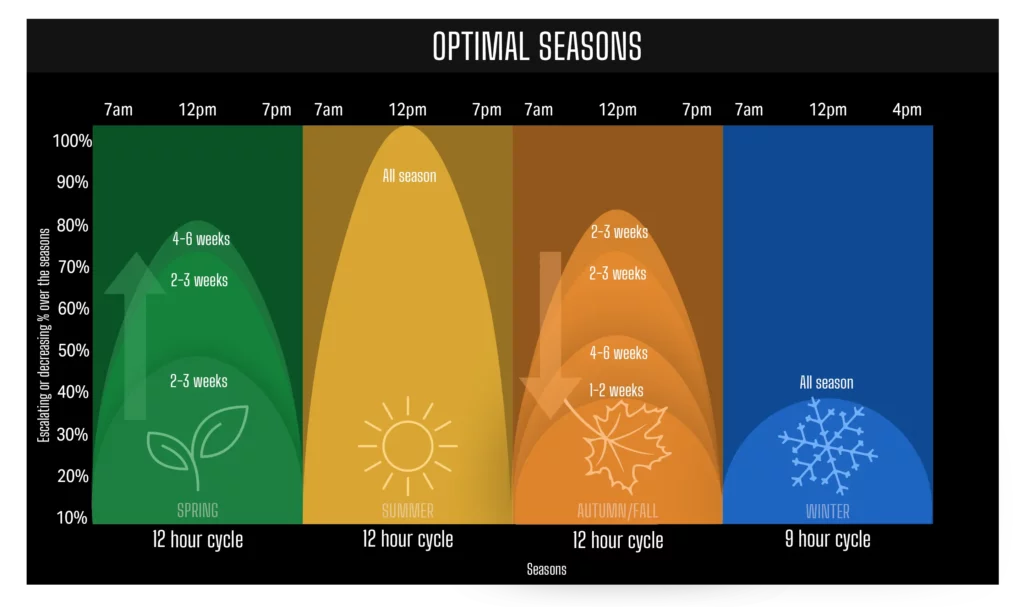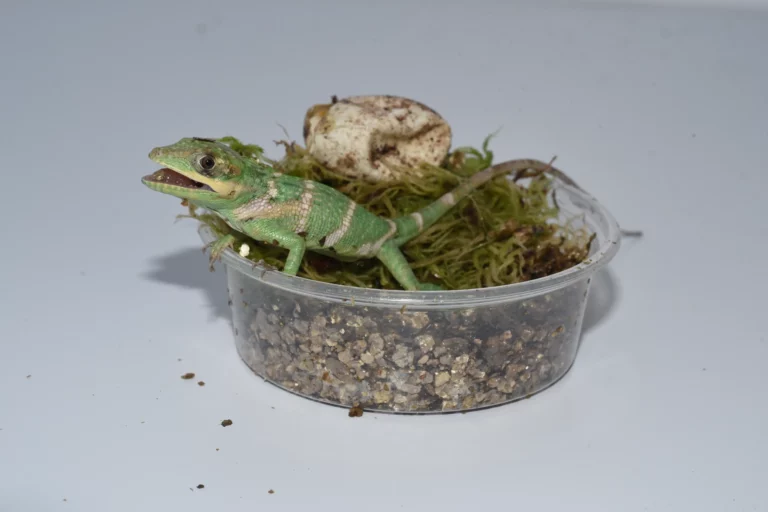Circadian rhythm plays a crucial role in the well-being and health of reptiles. By providing an illuminative cycle that mimics their natural day-night cycle, we can enhance their physiological and behavioural patterns. A well-regulated circadian rhythm allows for natural or wild-like sleep-wake cycles, feeding behaviours, thermoregulation, and hormone production in reptiles. This not only helps them maintain a healthy metabolism but also supports their overall growth, reproduction, and immune system function.
Additionally, a balanced circadian rhythm can positively reduce unnatural stressors. Including appropriate light and dark periods creates a sense of security and stability in the animal’s environment. This helps to promote natural behaviours, making them feel more comfortable and content in their habitats. With Arcadia Reptile LumenIZE® advanced lighting solutions, and the ability to create customizable lighting patterns, you can effortlessly recreate the natural day-night cycle for your reptiles, ensuring they truly thrive in an environment that supports their biological needs, whilst also lowering energy consumption and running costs.
Circadian cycles are essential for reptiles as they influence various aspects of their physiology and behaviour. By not providing reptiles with a natural circadian rhythm, several negative consequences can arise.
Reptile keepers must prioritise the provision of a natural circadian rhythm in their habitats. By doing so, they can help maintain the reptiles’ physiological and behavioural balance, promote overall health and well-being, and prevent the negative consequences associated with the absence of proper circadian and seasonal cycles.

Circadian and seasonal rhythms influence the production and release of reproductive hormones in reptiles. By providing a natural day-night cycle, it helps regulate the secretion of hormones such as luteinizing hormone (LH) and follicle-stimulating hormone (FSH), which are crucial for reproductive processes. Proper hormonal regulation enhances the timing and synchronization of breeding behaviours, follicle development, ovulation, and sperm production.
Circadian rhythms contribute to the expression of courtship and mating behaviours in reptiles. By aligning the lighting and environmental cues with their natural cycle, it stimulates the appropriate behaviours necessary for successful courtship and mating. This includes specific displays, rituals, and communication signals that facilitate breeding interactions between male and female reptiles.
Circadian cycles play a role in the reproductive physiology of female reptiles. It helps regulate the growth and development of ovarian follicles, leading to the production of healthy eggs. Proper timing of ovulation and egg development ensures higher fertility rates and improves the chances of successful fertilisation.
One of the most limiting things about historic lighting for reptiles is that it is either just off or on at full power. We all know that the power of the sun increases during the day and only remains at ‘zenith’ for a few hours before reducing again towards dusk. LumenIZE® control will allow you to control not only the length and power of the dawn and dusk cycles but also the length of the ‘zenith’ where the sun and therefore our lamps are most powerful.
The list below shows average ‘midday’ or full-sun exposure lengths per day on average summer days over the areas from which most ‘companion’ species are kept. You can use this data to create naturalistic full-sun photoperiods for your species.
We all know that daylight is never simply on (sunny) or off (night-time). The sun provides energy to all living things on our planet and therefore all living things have developed to use its abundant energy. Core to this is the ability of each species to take whatever energy that they need in the most bioavailable and safest way for them. Typically, the sun rises very early in the morning, let’s take the UK summer as an example for now. The sun starts to rise around 5 am. This is where energy starts to build as the earth moves slowly. As it does so more and more sunlight is available from being low in our sky. As the sun continues to rise, more and more light over the whole terrestrial spectrum is available until the sun is directly over us. There is then a sweet spot of a few hours over midday where the sun is at its most powerful, being directly overhead. Then as the sun starts to set, light levels decrease over the spectrum until we enter dusk and then night.
We can use LumenIZE® systems to create natural dawn until dusk rhythms which will provide lighting much more slowly and more naturally for our animals. However, we can take this a little further and yet again increase welfare through good naturalism. How? Well, the proportions of sunlight change as the sun rises and sets. You will see this easily as the sun is generally very red up until the zenith and then again at the end of the day. In reality, far more photons from the red and infra-red spectrum are available at this time of day, and far fewer are available from UV.
How can we use this to increase welfare? Quite simply by choosing heating lamps that are IR-A rich and setting them to start to come on early in the day, alongside the Arcadia Reptile LumenIZE® JungleDawn-LED Bar, we will be mimicking the large provision of IR and visible light through the early dawn. If we then set the LumenIZE® ProT5 to start to ramp up 1-2 hours after the LED and Heat lamps, with the whole system working together and continuing to build until mid-morning, when there is far more blue light and UV in the terrestrial spectrum, we will more naturally provide sunlight at its strongest, and therefore our replication will be more ‘sun-like’. We then simply reverse this at the end of the day. This is referred to as ‘staged lighting’, but with the added benefits of LumenIZE® which controls the provision of visible light and UV smoothly.


Visible light is vital for all life. Within the terrestrial spectrum, it is these wavelengths and quantity of energy that allows photosynthesis. As we have said before ‘all light is energy and all energy is used’. Therefore, visible light is also used by reptiles as expressible energy, but it also allows vital processes to occur in the brain and aids natural basking. We can use LumenIZE systems to greatly increase the quantity of visible light (lux) which will then help increase animal welfare and allow plants to grow more successfully. As with UV lamps, as light travels it spreads to cover an expanding area, sharing photons over this increasing area as it does so. In the same way, as we are used to UV lamps, visible light has a reducing level of energy as measured over distance. We can, however, use lux meters to measure total visible light and then buddy up JungleDawn LED products closely together. In this way, we see increasing quantities of light (increased lux). For tall enclosures where mid to low level planting is used this method of buddying up multiple lamps can be very effective indeed. Please see the average lux and PAR projections on the packaging and this website (measured without a mesh) to have an idea of the levels of lux and PAR that could be provided per distance in your caging.
Another limitation of historic fixed voltage reptile lighting systems has been the inability to create a realistic and naturalistic sense of seasonality. Many of the species that we keep have developed towards the seasonality of the earth per geographic area. We are all aware of the changing seasons and how these impact our own lives and the lives of the species that live around us. Reptiles of course have not only learned to survive in these times of reduced solar and nutritional energy, but many have developed in a way in which they are now reliant on seasonal change to instigate and allow for reproduction in the following seasons. There are very few equatorial species that experience little seasonal change in our collections, therefore most of those species kept have developed to utilise seasonal change and it would be more wild-like to allow for this within our care, this in of itself would be a welcome increase in animal welfare through modern care.

LumenIZE systems will negate the process of manually cycling animals down towards brumation and hibernation, but it will allow you as a keeper to bring in slowly changing decreasing and increasing energy levels as we cycle between the seasons. Rather than just reducing the illuminated period and dropping the temperature as is common now, LumenIZE will allow you to easily change the programming of the lamps per cage to gradually reduce not only photoperiods per day but also the intensity of both lux and UV Index. This can happen fluidly and with minimal effort from the keeper. Simply open the App and select the lamps that you wish to control. Change the % of power downwards towards autumn/fall over the length of duration that you wish this seasonality to occur and then reverse the process back after brumation/hibernation as you bring quantities of energy back up over spring and into summer.
It has been common for cage bird breeders to instigate breeding of common pet species by shortening and then lengthening the daily photoperiods, this has been practised for decades. LumenIZE takes this a step further for reptile keepers as the whole process is fluid and graduated rather than being reliant on sudden on/off drops or increases.
Arcadia Reptile LumenIZE systems of control can help increase the welfare of hatchlings and young animals. Once again, rather than being exposed to on/off lighting schedules of maximum output, LumenIZE not only provides a naturalistic circadian rhythm but can also be attuned to seasonal energy availability at the times from which young animals start to venture out into the world. Being small, fragile, and predator-aware, many species when young will feed in lower light rather than full sun or total darkness. Being able to have longer periods of sunrise and sunset, where energy from light is still available but offering more seclusion than full sun projection values, could enable young animals to experience less avoidable stressors and feed more readily.
LumenIZE control can be used to either create lower energy and elongated periods of dusk to allow watched feeding for young animals or reversely, shorter periods of high energy early in the day to allow basking and feeding and then periods of seclusion. This of course is dictated by the wild behaviour of each species.

CONTACT US
info@arcadia-reptile.com
Web Design by Soracle Media